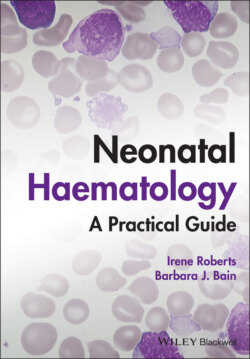Читать книгу Neonatal Haematology - Barbara J. Bain, Irene Roberts - Страница 30
Monocytes
ОглавлениеThere are few monocytes in early second‐trimester fetal blood (<0.06 × 109/l) but the numbers slowly increase to reach 0.1 × 109/l towards the end of the second trimester.101 Normal ranges for monocyte counts at birth in term and preterm babies are shown in Table 1.2. These show a gradual rise from a mean of 0.75 × 109/l in preterm neonates less than 28 weeks’ gestation at birth to 1.5 × 109/l in term babies.65 Monocytes play a key role in the innate immune response of neonates to pathogens. Investigations have shown that although the ability of neonatal monocytes to phagocytose microorganisms is not impaired, other aspects of monocyte function in neonates are impaired compared with adult monocytes.102,103 For example, neonatal monocytes have reduced expression of a number of functionally important cell surface molecules compared with adult monocytes, including HLA‐DR, CD80 and L‐selectin, which leads to a reduced ability to present antigens efficiently and to migrate to sites of inflammation.104 In addition, many studies have reported differences in the pattern of pro‐ and anti‐inflammatory cytokine production in neonatal monocytes, which may impair the antimicrobial activity not only of the monocytes themselves, but also of neutrophils,105–108 although their ability to respond appropriately to bacille Calmette–Guérin (BCG) vaccine appears to be preserved.109
